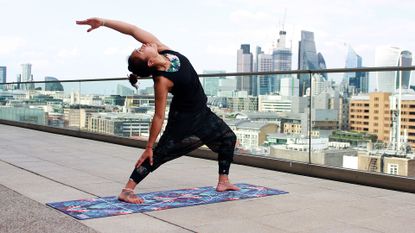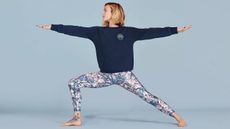Investing in the best yoga mat in 2023 can make a huge difference to your yoga or Pilates practice. For a relatively simple product, the yoga mat market is surprisingly varied, with options in different materials and at a wide range of price points. This can make figuring out which is the best yoga mat for you a bit overwhelming, but that's where this guide to the best yoga mats comes in.
At T3, we've reviewed lots of yoga mats and are here to walk you through your options and help you find the perfect one for your practice. Key things to look for are slip-free grip (for if your hands and feet get sweaty), and enough padding to keep your joints happy, but not so much that it upsets your stability. Beyond that, you'll want to look for something durable, eco-friendly, and if you're going to need to tote it around, not too heavy. Compared to other fitness activities, yoga is pretty equipment-light, so investing in the best yoga mat can really make a big difference to your comfort and progress.
Once you've made your decision, head to our guide to how to clean a yoga mat for tips on keeping it looking (and smelling) like new for longer. And you might also want to consult our best yoga pants guide for the comfiest, stretchiest options around.
- Invest in the best yoga blocks, to help you push your poses further
- Or take things up a notch with the best yoga wheels
- Yoga vs pilates: Which is better for you?
Best yoga mat ranking 2023
Why you can trust T3 Our expert reviewers spend hours testing and comparing products and services so you can choose the best for you. Find out more about how we test.

The best yoga mat you can buy
+ Great grip
+ Helpful line markings
+ Extremely durable
+ Larger than standard size
- Quite heavy
The best yoga mat is the Liforme Yoga Mat. Made from natural rubber with a unique eco-friendly polyurethane topper, it delivers excellent grip straight out of the box, even when tackling a sweaty hot yoga class. There are a series of marking on the top that are incredibly helpful in keeping you correctly aligned in your poses. As you start your practice, you'll quickly see when and where different body parts are meant to line up.
Compared to standard yoga mats, you're getting a bit of extra width and length to give you plenty of room to move through your poses. I think the thickness is ideal: enough to keep bony bits comfortably off the hand ground, but not so much as to send you wobbling around in balance poses. Head to our full Liforme Yoga Mat review for more.
Our rating: 5 out of 5 stars

The best cheap yoga mat
+ Incredible value for money
+ Excellent grip
+ Very long lasting
- No positioning guidelines
- Not as durable as rubber
If you're on a tight budget, Gaiam's yoga mats represent incredible value for money. The surface has a light, tacky feel that provides plenty of grip – this non-slip surface lasts incredibly well even over years of use. Although it's made from PVC, it's free from latex and phthalates, making it less harmful to the environment than some other PVC mats. The spongy texture means they're lightweight, and they're also typically cheaper than other materials.
There's a wide range of designs, sizes and thicknesses to choose from, so you can pick the one that suits you, and the lifetime guarantee sets your mind at ease. In terms of bang for your buck, you'd struggle to do better. Head to our Gaiam yoga mat review for more info.
Our rating: 4 out of 5 stars

The best cheap Lifeorme alternative
+ Useful alignment guides
+ Extremely good value
+ Excellent grip
- Not as eco-friendly as Lifeorme
The Core Balance Alignment Yoga Mat seems to be positioning itself as a Lifeorme alternative, and we have to say it's done an excellent job. For a much lower price, you're getting excellent grip, and a similar design . It's slightly wider than your average yoga mat, and comes with useful etched alignment guidelines to help with positioning.
This mat is made with PU on top of natural rubber base – Lifeorme uses its own 'eco-polyurethane' for the topper, which suggests it's more eco-friendly, although Core Balance has confirmed that its whole mat, including PU topper, is biodegradable, so it's hard to say really. A velcro strap comes included, and you've got four colours to choose from. Head to our Core Balance Alignment Yoga Mat review for the full low-down.
Our rating: 5 out of 5 stars

The best yoga mat for incredible grip
+ Unbeatable grip
+ Sustainably made and biodegradable
+ Reversible
- Marks easily
- Carrier not included
The Yogamatters Eco Flow mat has a textured and slightly tacky surface that offers the best grip out of any yoga mat we've come across. In our Yogamatters Eco Flow yoga mat review, our tester found it retained its grip impressively well in a clammy hot yoga class, so it can certainly deal with a bit of moisture.
It's available in a range of cool, unusual colours, although it does mark and pick up dirt and dust easily, so it's not easy to keep it looking smart. The plainer design means you can flip the mat and use either side, which should help extend its lifespan. This is one of the brand's premium options, but with the same eco-conscious design choices you'll find in the rest of the range. It's made with sustainably harvested natural tree rubber, and is recyclable and biodegradable at the end of its life.
Our rating: 4 out of 5 stars

The best sustainable yoga mat for tough grip
+ Sturdy, cushioning & comfortable
+ Tough grip
+ Made from sustainable materials
- Heavy
The Complete Unity Yoga CompleteGrip Yoga Mat is a newer product to the yoga equipment market but it definitely earns its place in this best yoga mat guide. The mat features grooves and patterned grips which helps users stay stable in their poses and the mat itself doesn't move around as you adjust and move. It's a brilliant mat for yoga and for intense workouts, although we did find that it gets a bit wet if you're sweating a lot.
One thing that sets the CompleteGrip Yoga Mat apart is its eco-friendly credentials. It's made from sustainably harvested natural tree rubber and jute fibres, and it's made using a zero-waste manufacturing process. The mat is also plastic-free, PU-free, BPA-free, TPE-free, PVC-free, microfibre-free and vegan friendly, plus it's pretty affordable, too. See our full Complete Unity Yoga CompleteGrip Yoga Mat review for all the details.
Our rating: 4 out of 5 stars

The best cork yoga mat
+ Eco-friendly
+ Naturally grippy
+ Cool range of designs
- Big logo
- Cork mat marks with sweat
One of the best yoga mats made from cork comes from With Every Atom'. This brand is focused around ethical practice, and all of its mats are vegan, and made from sustainably sourced, natural and recycled materials. Design-wise, With Every Atom goes a little funkier than your standard yoga brand too, throwing cool leopard and tiger-print options into the mix alongside bright natural rubber designs (although I personally would prefer if the logo was a little subtler and smaller).
Its cork yoga mat features a non-slip, cushioning natural rubber base with a sustainably-sourced premium cork topper (both are biodegradable). The cork is naturally grippy, and absorbs moisture without becoming slippy – I found it worked remarkably well, maintaining its grip even in a sweaty class. The only slight down-side is that I found it marked easily with sweat.

An eco-friendly, grippy mat at lower cost than a Liforme
+ Great grip
+ Useful alignment markings
+ Eco-friendly
- Can bunch occasionally
If you want the eco-friendly natural rubber of a top-end yoga mat that offers superb grip, in the wet or dry, but can't stretch to the cost of a Liforme, the next best thing is this Yogi Bare Paws yoga mat. Somehow the Yogi Bare gang have managed to offer much the same material as Lifeforme but at a far cheaper price.
There are a few compromises: it's slightly smaller in size and thinner too, and the line markings aren't as useful but there are still a few that help with the basic moves. The grip is still there, though, and there's enough support from the thickness. A few customers note that this mat could bunch a bit at times, meaning you need to smooth it out again between moves, but only a little. For the price, this is one of the best yoga mats out there.

A fully eco-friendly mat that delivers unbelievable grip
+ Incredible grip
+ Sustainable and biodegradable
+ Great price
- Odd smell
- Rubber wears away over time
- Thinner than alternatives
Normally, you'd expect to pay premium for an ethically produced eco-friendly product; not so with the Yogamatters Eco Rise Yoga Mat. It's made from sustainably harvested tree rubber, with no dyes, and is fully biodegradable at the end of its life, and still comes in at an incredibly competitive price.
The sturdy, compact structure offers more padding than you'd expect from the 3mm thickness, and the slightly textured cotton-blend mesh surface delivers incredible grip from the off. Do be aware though that the top surface will gradually wear away over time (it's basically like a giant eraser). In our full Yogamatters Eco Rise Yoga mat review, our tester found there was a slightly odd smell that lingers a bit. Don't let that put you off though, because this sustainably made yoga mat has plenty to offer.
Our rating: 4 out of 5 stars

The best cheap mat for beginners
+ Thick comfort
+ Affordable
+ Decent lifespan
- Not the most robust
If you're on a tight budget, the best yoga mat for you might be the Ekotex Eco Sticky mat. It's lightweight, provides good grip right from the start, and the generous 5mm depth is plenty of padding to keep your joints happy as you practice. It's made with Polymer Environmental Resin (PER), which makes it more eco-friendly than your average PVC yoga mat, and the packaging is zero-plastic too.
The price is low, and that means you sacrifice some longevity, so if you need a mat that'll withstand heavy use, spend a bit more and go for a rubber mat with a polyurethane (or eco-alternative) top surface. That said, our reviewer was impressed with how much use they got out of it before it started to show signs of wear and tear. Head to our Eko Sticky Yoga Mat review for more info.
Our rating: 4 out of 5 stars

The best yoga mat for petite yogis
+ Lots of super cool designs
+ Markings great for shorter people
+ Eco-friendly company, recyclable packaging
- Slippy when dry
Form is an independent company that makes a range of eye-catching yoga mats. The standout here is the prints: the 'Pro' range all have a soft-touch fabric top layer that's printed with an eye-catching pattern. The top layer has 'sweat activated grip', which means it needs to be slightly damp to work. In my tests I found it quite slippery when dry, but as soon as my hands and feet started to become clammy, they stuck like Spider-Man.
The alignment grid looks nice and abstract but works well in terms of the angles. I think they'd work better for shorter people – I'm 5'8", and I found the grids slightly too close together to suit me. This company has some strong sustainability credentials. The brand is certified climate neutral, and all of its mats are carbon-negative, made from recycled natural rubber and (for the patterned mats) a top layer made from recycled plastic bottles with water-based dyes. They arrive in fully recyclable and biodegradable packaging.

The best yoga mat for travel
+ Nice and grippy
+ Lightweight for rubber
+ Reversible, with two different textures
- Marks easily
- Textured side has poor grip
if you're looking for a yoga mat for travel, the Lululemon Reversible Mat is a great versatile, lightweight option. First, you're getting two textures for the price of one: the smooth side will see you through the sweatiest hot yoga class without a slip, while the textured side will work for calmer practices. This mat is also nice and lightweight for a rubber. Admittedly, this is partly because it's just 3mm thick, but that'll still provide a nice cushioned layer.
Sustainability-wise, Lululemon gets half marks, mixing eco-friendly rubber with a polyurethane top layer that's not so good for the planet. The only other slight down-side is that our tester found that this mat became marked with sweat fairly quickly. Overall though, it's still a great all-rounder, and especially handy for those who want a mat to tote around. You'll find out more in our Lululemon Reversible Mat review.
Our rating: 4 out of 5 stars

The best looking yoga mat
+ Attractive designs
+ Sustainably made
+ Can be washed in the washing machine
- Slippy when dry – spray before use
While a pretty design isn't the most important thing, it sure does help. If you're looking for something that stands out, the best yoga mat is from Willow Yoga. The attractive, floral designs are printed on a microfibre top layer that's soft to touch. This layer is absorbent and grips better the sweatier you get. In my tests, I found the grip is reliable when my hands and feet are a little clammy, but fairly slippy at the beginning of a practice (the company recommends misting the mat with water before you start).
Willow Yoga has impressive eco-credentials. All the mats in the range are sustainably made using only eco-friendly, biodegradable materials, and are free from PVCs, silicone and phthalates. You can even pop it them the washing machine (without detergent) when they need it, too. The simple design, fashioned from a single piece of wide webbing tape, works an absolute treat and lets you show off the mat while you're on the go, too.

The best yoga mat for on the move & comfort
+ Superb support and comfort
+ Ideal size for portability
+ Lifetime guarantee
- Needs use to break-in grip
While Manduka does use PVC materials (latex free though), it's process is OEKO-TEX certified, meaning it's friendlier to the environment and comes with a lifetime guarantee. The 4.7mm of thickness this offers is supported by dimpled cushioning making it super comfortable while also stopping sweat absorption to keep it cleaner for longer. The grip could be better initially, but after a bit of use this improves.
An initial processes of leaving this covered in sea salt for 24 hours is required for early-use grip – a bit of a faff but worth it. The weight and size is portable without compromising on comfort, making it ideal for taking to classes with hard floors.

Portable, comfortable, eco-friendly & affordable
+ Excellent grip
+ Eco-friendly
+ Decent thickness support
- Could be wider
Jade Yoga prides itself on creating eco-friendly yoga mats while also dishing out some very eye catching colours that don't scrimp on surface grip. The result is a real all-rounder which manages to offer enough grip and thickness to support a beginner or a pro yogi and everyone in between too.
Three size options are available, making this adaptable to suit taller and shorter yogis alike. The price is really impressive for what you get and the portability makes this one of the best yoga mats for toting back and forth to classes.
How thick should your yoga mat be?
A good place to start on your hunt for the best yoga mat is comfort. A standard yoga mat thickness is 4mm, so that should be your starting point. If you're a bit more hardcore and/or are practicing on a softer surface, you might be able to drop to 3mm, but you won't find mats much thinner than this.
If you have more sensitive joints, consider something thicker – you'll find mats up to around 8mm thick. However, there are a few things to know here. While you might think thicker equals more comfortable, that's not always the case. If you go too thick, the more unstable surface can be tough on the wrists and ankles on longer yoga sessions, and you're likely to end up wobbling around in balancing poses.
Aside from thickness, there are a few more elements to consider when finding the best yoga mat for you. Next up, think about grip. Finding a mat that'll cope well with sweaty palms and soles is key, especially if you do hot yoga (here's how to choose a hot yoga mat). The better the grip, the more you can push your limits without the distraction of slipping on the mat yourself, or the mat slipping on the floor. While adding one of the best yoga towels can help, there are plenty of yoga mats that offer good grip on their own.

Size is another major consideration. You may want the biggest possible mat so you can stretch out without reaching the edge – and also mark a bit more precious territory in that yoga studio. But size does mean more to carry, so considering more portable options, especially if you're on the move a lot, is also a factor.
Material is also a major consideration when picking the best yoga mat, in terms of comfort, portability, and eco-friendliness. Yoga mats made from polymer plastic (PVC) with phthalates won't biodegrade, and will release toxins when in landfill. However, lots of yoga companies have started exploring eco-friendly alternatives. The result can sometimes mean a compromise in quality or a different smell, but may also mean a more gentle cleaning process is needed.
Foam mats tend to be more lightweight than rubber ones, which is important if you're going to be toting it around a lot. However, they often have a bobbly, textured surface that can wear and become damaged fairly easily, impacting its shelf life in the longer term. Many also need to be 'broken in' to improve grip.
One consideration you may not have thought was important is line markings. Lots of mats now offer these to help you align your hands and feet so you know you're symmetrical. This is ideal for those with an imbalance or anybody just starting out that wants to be sure they're progressing in the right direction immediately.
Finally, you'll want to set a budget. The best yoga mats can be pretty expensive, while at the other end of the scale, you can pick up a super-basic option for peanuts. It's often worth spending a bit more for a mat that'll last – after all, you don't need much kit for yoga. So, with all that in mind, here are the best yoga mats out there right now.
In short, if you're doing Pilates and don't need to do much balancing, a thick and spongy mat might be the comfiest choice. For yogis, we'd recommend a thinner, more stable rubber mat for the best cushioning without affecting stability.
How we test yoga mats
Wherever possible, we call in a sample of the yoga mat to test out properly for ourselves. Reviewing is done by experienced practitioners who have used a range of mats over the years and know what makes a great yoga mat. We'll try each mat for a few classes / sessions, assessing how well they grip in tricky poses, how stable they are to balance on, and how comfortable they are. We'll also see how they perform in a sweaty hot yoga class, and keep an eye out for things like whether they mark or shed easily.
Where we aren't able to get hold of a mat to test personally, but feel it's significant enough to include in a guide, we'll research around the product and read what other customers say about it, to put together a balanced blurb for you to make your decision based on. For all mats, we'll factor in what we know about the brand's reputation, how sustainable the mat is in terms of materials used to make it and whether it can be recycled at the end of its life, and how it compares to other similarly priced options. See how we test at T3 for more.











